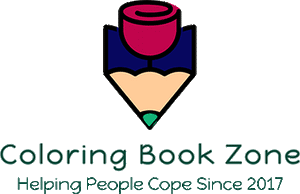Does someone in your family suffer from the debilitating effects of dementia? If so, you know first-hand how challenging it can be to engage and relate to them in a meaningful way. An adult coloring book for seniors with dementia can be a perfect way for them to build confidence and skills while they relax.

You probably go through a mental checklist before you visit your loved one with dementia. Your list may include the following questions: Is it better to visit in the morning or the afternoon? When will he/she be most lucid and will they know who I am? Will today be a “good” day or a “bad” day? Should the entire family come along – or will too many people cause confusion and frustration? How will we pass the time? Is there an activity we can do together that will be both calming and engaging?
How Coloring Helps Dementia
Believe it or not, research suggests that adult coloring can be extremely beneficial to those struggling with dementia.
Most people are aware of the adult coloring craze sweeping the nation. Why would coloring help people with dementia? Coloring translates across ages. It is universal. Anyone – young or old – can do it. It is not stressful like drawing – all you need to do is add color to shapes. It is an extremely entertaining and distracting activity which can help alleviate stress, agitation and frustration in patients with dementia.
Adult coloring also helps loved ones socialize and interact with their family and peers, while at the same time improving hand eye coordination and fine motor skills. Coloring is an activity the entire family can participate in and before long your loved one will have a table full of residents hoping to join in on the fun.
Research Proves Coloring Can Help
Other articles and studies indicate that coloring can delay the progression of dementia while also allowing the fear center of the brain (the amygdala) to relax. One study shows that giving your amygdala periodic rests actually reduces stress and agitation. Because coloring mimics a meditative state, giving your brain that much needed “down time,” one can actually “retrain” the amygdala to respond less harshly to stress. In fact, this coloring induced meditative state has other health benefits, including a reduction of anxiety, stress, and depression - to name a few.
In a 2009 study conducted by clinical psychologist Jackie Andrade, she posited that adults who “doodled” while listening to a list of random names read aloud, would have better recall than those who didn’t “doodle.” She found that the doodling group had 29% better recall compared to the other group. Interestingly enough, the “doodling” they were doing was actually coloring.
Designing The Perfect Coloring Book for Seniors
Your choice of coloring book for a loved one with dementia is also important. For example, whimsical settings might confuse someone struggling to differentiate fantasy and reality. The book should have some retro or nostalgic images that older people can relate to. The pictures should be large enough to color – without looking childlike – yet not so intricate that they cause frustration. It is also a good idea to use colored pencils instead of markers because markers can get messy.
Because this topic is extremely close to our heart, we have worked with experts to design great adult coloring books for seniors.

